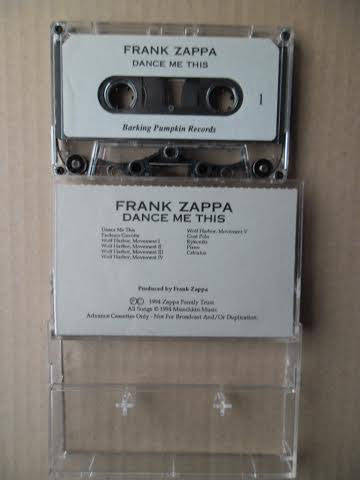The Tuvans In California
Chronology
- Wednesday, December 30, 1992—Khovalyg, Kuular and Ondar arrive at LAX.
- Friday, January 1, 1993—Rose Parade.
- Tuesday, January 5, 1993—Caltech; Matt Groening meets the Tuvans..
- Wednesday, January 6, 1993—UC Santa Barbara.
- Friday, January 8, 1993—the Tuvans record at UMRK; Chieftains, Johnny Guitar Watson, Shankar, etc.; BBC filming.
- Saturday, January 9, 1993—Bowers Museum Of Cultural Art.
- Saturday, February 13, 1993—Victory Park, Pasadena.
- Monday, February 15, 1993—the Tuvans record again at UMRK; Matt Groening's Birthday; FZ plays "Calculus" to the Tuvans.
- Tuesday, February 16, 1993—the Tuvans fly to Amsterdam.
- July, 1993—Ondar at UMRK; then Huun-Huur-Tuu (Khovalyg, Kuular, and Sayan Bapa) after recording with Ry Cooder for the soundtrack of Geronimo; also members of Gorky Park.
- October 3, 1993—Ondar appears at The Chevy Chase Show with his student Bady-Dhorzu Ondar.
- c. October, 1993—Ondar, his wife Lyuba, and his student Bady-Dhorzu at UMRK.
Ralph Leighton [...] plans to send a trio of yodeling Russian cowboys clip-clopping and khoomei -ing down Colorado Boulevard. They are Tuvans, members of a small band of nomadic Asians who live in southern Siberia and are known for their unusual ability to sing two notes at once. [...] On Wednesday [December 30, 1992], Kaigal-ool Khovalyg, Anatoly Kuular and Kongar-ool Ondar had barely collected baggage containing the fur hats, shiny silk robes and curved-toe boots they will wear in the parade when Leighton rushed them to a stable to introduce them to the horses they will ride.
Three Russian singing cowboys who rode in last week's Rose Parade to the sound of a high school band plan to march to their own beat back to Pasadena today. Singing horsemen from the remote Russian area of Tuva—who were unexpectedly drowned out by a band marching behind them on New Year's Day—will stage free concerts at noon and 7:30 p.m. at Caltech. [...] The noon concert will be at Caltech's Olive Walk; the evening performance will be in Baxter Hall.
The highlight of the Saturday [January 9, 1993] performance at the Bowers Museum of Cultural Art will be the exotic vocal performance known as "throat singing," in which the singer lets out a light whistle and a deep chant at the same time. [...] The Tuvans are in the United States on a two-month mission designed to expose the West to their unfamiliar culture. Last week, the group participated in the Rose Parade. On Saturday they will dress in traditional costumes, recite folk stories and sing.
Orange County residents will have the opportunity to hear this "music from the ends of the earth" today [January 9, 1993] from 3 to 6 p.m. at Bowers Museum of Cultural Art in Santa Ana.
[...] Rada Chakar, a Tuvan woman who is serving as translator for the singers, who arrived in the United States on Dec. 30 after a two-day flight from Tuva to Moscow to Los Angeles International Airport.
[...] Said Chakar: "If they practice at all, it is only when a concert date is looming. These three, for instance, have never before performed together. But they get together with different groups all the time."
[...] The Tuvan throat singers appear today at 3 p.m. at Bowers Museum of Cultural Art, 2002 N. Main St., Santa Ana.
Rada Chakar has been in LA for several months, as she works to pioneer trade between Tuva and the USA. She has been acting as a translator for the three singers, since she was formerly a teacher of English in Tuva and speaks impeccable English. She rode in the Rose Parade with the singers, although she does not normally ride a horse. When asked her opinion of sitting on a horse for upwards of three hours without the benefit of prior experience, she admitted only that the following day she felt much better than she had predicted.
Rada's younger brother, Sayan, arrived with the three singers to join his sister in her business efforts. He is husky, as Tuvans go, and his French is on a par with that of your humble reporter, which is to say "not all that great". Sayan is enamoured of the American way of life and is eager to learn English—he brought over a Russian/English translation dictionary to speed the process.
January 5, 1993—Matt Groening meets the Tuvans
The most unbelievable aspect of my view of the Tuvan trip to LA (history as I see it... :-) ) occurred as Ralph Leighton and hardcore volunteers set the stage before last Tuesday's [January 5, 1993] concert at Caltech.
As Ralph describes it, he was struggling to arrange the stage quickly before the audience arrived, when a dishevelled man approached and persistently asked to speak to Ralph. Ralph relented, and the man produced his business card....Matt Groening. Matt then explained that he had heard the Tuvans on the radio and his friend Frank Zappa wanted to attend the concert but couldn't make it (is this getting unbelievable yet?). Nevertheless, Zappa was having the Irish band The Chieftans over to his place on Friday (that would be last Friday) [January 8, 1993] and wanted to invite the Tuvans to come over to his home recording studio at the same time. (Note that I am NOT making this up...:-)) . Anyway, Ralph and the Tuvans went, and we'll have to wait for the next Friends of Tuva newsletter for the outcome.
Matt Groening, 2003 DVD Commentary Track for Futurama, Season 3, Episode 10, "Where The Buggalo Roam," 2002
When the Tuvans came to Los Angeles for the first time they performed at Caltech. I heard them, they were singing live on KPFK, and I called Frank Zappa, I knew he would love that kind of music, and I said, "Hey, turn on the radio! You wanna go see 'em? Let's go se 'em." And he said no, he wasn't feeling well enough, but invited the Tuvans over to his house. And I did, I admitted my mission, I went to Caltech and I banged on the auditorium door, 'cause they were rehearsing. "Let me in! Let me in!" And I said, "Frank Zappa would like to meet you." They knew who Frank Zappa was. Anyway, so they came over and Frank recorded them and he put some stuff out with them. Yes, really cool.
January 8, 1993—Salon Evening
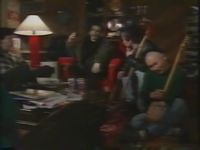
Incidentally, the Tuvans (and Ralph) had a fantastic time at Zappa's home/recording studio. The BBC was there, so it might show up on a documentary.
Despite his illness, despite no longer performing live, Zappa has lost none of his relish for experimentation. He recently held what he called a Salon at his house, where he recorded the combined sound made by the Chieftains from Ireland, a Tuvan throat singing group from Mongolia, and his old friend Johnny Guitar Watson.
Ralph Leighton, Dance Me This (liner notes), June, 2015
January 2, 1993—Caltech, in Pasadena, California. The audience is ecstatic, transported to another world by the ethereal sounds of throatsingers from the lost land of Tannu Tuva—that Siberian Shangri-La once famous for its triangular stamps collected by a young Richard Feynman. An earnest bearded man wearing glasses, with a determined look in his eyes, approached me after the concert: "My name is Matt Groening. Frank would like to meet the Tuvans."
"Frank?"
"Zappa."
The next night, the Tuvans entered the UMRK. The Chieftains and Johnny "Guitar" Watson were already there. What ensued was captured by BBC TV, which was producing a documentary about the living legend Zappa, who not only charmed the guests, but also managed to make the first studio recording of Tuvan throatsingers in the United States. (Frank's ensuing composition "Calculus," featuring the voice of Tuvan throatsinger Anatoly Kuular, is mind-bending!) The magical evening peaked with the Tuvans playing "the came caravan song"—the Chieftains and L Shankar adding Irish pipes and an Indian violin to the mix, while Johnny "Guitar" Watson chanted, "Bringin' home the sheep! Bringin' home the sheep!" and Frank strummed happily on his guitar.
One of the most spectacular salon evenings produced what might just have been the most peculiar recording session in history—peculiar, that is, for the disparate styles of the participants: The Chieftains (the Irish folk music ensemble non pareil ), the magnificent drummer Terry Bozzio, blues guitar legend Johnny "Guitar" Watson, jazz/fusion violinist L. Shankar, and several Tuvan "throat" singers from northern China. The Chieftains piped and plucked, Bozzio thumped, Shankar fiddled, the Tuvans whipped up a Mongolian folk ditty in their unique, nasally, double-toned drone (the song concerned their nomadic life as herdsmen), and Watson strummed minor chords, periodically offering the Tuvans chuckling, pithy encouragements like "Sing about them sheep, now." The master of ceremonies particularly relished recounting that eclectic night, despite the fact that pain forced him to retire early (some of that session will be released on Dance Me This, one of several forthcoming albums Zappa managed to complete).
See also:
February 15, 1993—Second UMRK Visit
There will be another concert at Victory Park in Pasadena on Saturday, Feb 13.
There *may* be a concert on Sunday, Feb 14 at Caltech.
On Monday afternoon [February 15, 1993] I pulled up at the house of Frank Zappa. [...] About 20 minutes after the Tuvans arrived, a very pale Frank Zappa came into the room we were all milling around in. Present were Gail and Moon Zappa; Phil Abrams, the Amazing Bubble Man; Chris Sykes, who did the NOVA documentaries on Feynman (and a new two-part documentary on Feynman that just aired in Britain); Ralph's family; all Tuvans except for Rada, the translator (who showed up later); Darryl and Brenda Henriques, who were preparing the food; and Natasha, an expatriate Russian musician, who served as translator; and a couple of people I didn't get introduced to.
Zappa presented the Tuvans with a tape of the performances they did for him during Zappa-Tuva I, and a little "extra something." The performances were very good, and the tape (to my ignorant ears) sounded well engineered. The "extra something" turned out to be a solo track by Anatoly Kuular, to which Zappa's engineer had overdubbed some funky bass and rhythm ("using calculus!" Zappa repeated many times).
[...] Zappa explained that in addition to sampling the Tuvans singing, he wanted to have them improvise something to a rather heavy piece of heavy metal that he had created.
[...] Matt Groening (of Simpsons fame) turned up a little later. It was his 39th birthday [Monday, February 15, 1993], so we converted a half eaten chocolate log cake to a birthday cake and sang "Happy Birthday" to him, complete with throat-singing. The Tuvans followed Zappa to the studio to begin the musical experiments that Zappa wanted to try. [...] The recording seemed to go well, although the improvisation experiment with Heavy Metal that Zappa was trying wasn't working to his satisfaction, so he called it off. [...]
The next day the Tuvans boarded a plane to Amsterdam to begin their four day journey home.
July, 1993—3rd UMRK Visit
Actually, the Bappa's were at Zappa's. "Huun-Huur-Tu" did show up at Zappa's after their last day at the movie studio [recording the soundtrack of Geronimo with Ry Cooder]. They were there for a short time before heading to the airport for their flight to San Francisco. However, Ondar was the focus of the evening. In fact, he arrived earlier because he did not participate in the movie soundtrack. He was supposed to, but the "Huun-Huur-Tu" boys did not want him to be part of it.
Valentina Suzukei, Singing My Life: The Story Of Kongar-ool Ondar, Legendary Throat Singer From Tuva, 2014
Chapter 15: Meetings With Frank Zappa
After they walked in the Rose Parade in January 1993, Kaigal-ool, Anatoly, and Kongar-ool set off on a concert tour across the US. One day on tour, an excited and surprised Ralph [Leighton] told them that Frank Zappa personally invited them to his house. At the time, none of the guys had any idea who Frank Zappa was, so they didn't quite get his enthusiasm, but Ralph couldn't stop talking about it.
They arrived at the house, and Zappa invited them in like they were old friends. He immediately took them to the studio and they recorded some tracks his friends. After the short meeting, they had to get on the road and they went on to perform in several states.
In early February, when they were already in Los Angeles, Ralph told them, "Frank wants you over again. This is unheard of!"
This time, Zappa called up an old friend, the famous bluesman Johnny "Guitar" Watson.
"Listen, you have to come over," he spoke into the phone. "I've got some really unique musicians over at my house right now. I don't know when we will get to meet them again, so get over here!"
Watson was over in just a few minutes.
"There were also musicians from Ireland and Afghanistan," Kongar-ool told me. "We all just jammed and sang together, and everything was recorded on video. I still have those tapes at home."
The third meeting between Kongar-ool and Zappa happened in July of that year. By then, the group had grown to six members: Kongar-ool, Kaigal-ool, Anatoly, the brothers Sayan and Alexander Bapa, and Radomir Mongush. Ralph told them that Zappa had invited them over yet again. When they arrived at his house, they found two other musicians wandering the spacious foyer. They were Alexander Belov and Alexander Lvov, members of the popular Russian band Gorky Park. When the Tuvans heard them speaking Russian, they went over to talk.
"How did you end up here?" they asked.
You could read the disdain on their faces as they wondered what these people were doing at the home of Frank Zappa.
While they were talking, Zappa came out to meet them, and first went over to the Tuvans. After hugging each of them, he turned to the other musicians and said, "These are my best friends. Have you had a chance to meet them?"
The pair was almost speechless after they saw how Zappa treated the Tuvan musicians.
"They had no idea what we did, and why Zappa was so excited to see us," said Kongar-ool.
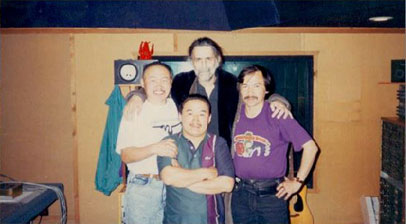
[Kongar-ool, Anatoly, Kaigal-ool & FZ.]
They didn't jam that time, and just sat and talked for several hours. The two Russians just listened while Zappa played the recordings from their last session.
Their fourth meeting happened that fall, right around the time that Kongar-ool brought his wife and his student for the AT&T campaign. When Zappa heard that a little boy was performing khoomei, he immediately invited them to his house. He was amazed and adored the little khoomeiji. By then, the great musician was confined to a wheelchair. That visit ended with a family dinner with Zappa's children and his wife, Gail. She gave Kongar-ool's wife a pair of gold earring. Lyuba still treasures them and only wears them on special occassions. Of course, little Bady-Dorzhu also got lots of gifts.
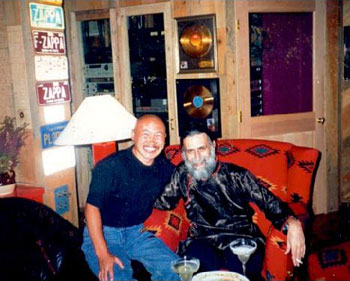
[Kongar-ool Ondar & FZ.]
During the second tour of the Throat Singers of Tuva in the United States (1993), there was a bifurcation among the musicians that led to Huun-Huur-Tu forming without Kongar-ool Ondar. Kongar-ool returned to Tuva and launched a throatsinging training program for youth at the Republic Arts High School in Kyzyl (Ralph Leighton, personal communication, 17 April 2014). Kongar-ool toured again in the United States later in 1993 along with one his students, Bady-Dorzhu Ondar (b. 1984), and they gave numerous performances together, including one on the Chevy Chase Show (3 October 1993).
October is the tenth month of the year, a number quite appropriate for Kongar-ool Ondar (whose last name means "tens" in Tuvan) to visit the US and Canada. Officially appearing in New York to represent AT&T and its new DISQ recording system at the Audio Engineering Society convention, Ondar and his 9-year-old student from the Lyceum of Tuva, Bady-Dorzhu Ondar (no relation), also found time to appear on the Chevy Chase Show (no, they were not the reason for the show's demise!), and to sing in a benefit concert for Tibet that featured Tibetan monks and Kitaro. (That program was broadcast in Japan, and the Ondars' appearance may form another segment in The Tuvans Invade America [...].)
The Ondars also appeared at the Glenn Gould Studio in Toronto for a CBC Radio documentary, to be aired on "Ideas" next year.
Huun-Huur-Tu
Charles Ulrich, April 2, 2011
In the booklet of Huun-Huur-Tu's 60 Horses In My Herd (Shanachie 64050), "Song of the Caravan Drivers" is "In honor of Frank Zappa, who loves this song."
Tuvans & Surround
Theodore Levin, Where Rivers And Mountains Sing: Sound, Music, And Nomadism In Tuva And Beyond, 2010, p. 60
"Bring me stones," Sayan [Bapa] ordered. "We need to do some construction work." The rest of us fanned out along the length of the stream, collecting stones to bring back for Sayan's and Tolya's inspection. Sayan chose a few stones of different sizes, placing them strategically in the flow of the brook to create various sound effects, and in one spot he fashioned a small cascade. When he was done, we all listened attentively ot the results of Sayan's craftmanship.
"That's it!" said Tolya at last. "That's the sound Tuvans like. It's when you can hear sound coming from all directions at all levels—when sound maximally fills a space." Or something like what audiophiles would call "surround sound."
Release Story
Joachim Ott
Now look at the html-source of that page. (http://www.zappa.com/)
In the keywords, they didn't mention "Freak Out" and "Absolutely Free" and "Lther". Otoh, there is "Dance Me This", "Trance-Fusion", "The Rage And The Fury".
Wtf?
kio, January 31, 2002
Subject: Re: new release in febuary
just trust me
"dance me this"
1 disc
details soon
Record Collector, February, 2004
The Zappa Family Trust plans to issue several archive audio and video recordings by Frank Zappa later this year, overseen by Frank's wife, Gail, and his son, Dweezil Zappa. A documentary film about Zappa's classical music, directed by Frank Scheffer, should emerge by Christmas. Remastered reissues of the Dance Me This and Trance-Fusion albums are planned too, along with two films and their soundtracks. One is about one of Zappa's inspirations, Edgard Varese, and the other a revamp of the 1974 in-concert film, Roxy And Elsewhere.
Gail revealed [...] that Dance Me This and The Rage And The Fury should be out by 2012.
Dance Me This?—2011
Within the year from now.
The 100th [album] will actually turn out to be the one Frank actually made which is "Dance Me This."

Dance Me This
FZ’s last album.
#100.
Tap your foot algorithmically to this!
PRE-ORDER!
We expect this item to ship on or around Monday June 1, 2015.
We expect this item to begin shipping on or around Friday June 19, 2015.
Barfko-Swill, June 19, 2015
Thank you for ordering from Barfko-Swill store. One or more of your items has shipped. [...]
PRODUCT(S) SHIPPED: [...]
ZPCD170 PRE-ORDER Frank Zappa—Dance Me This (CD) 1 1
11. Calculus
Todd Yvega, Dance Me This (liner notes), June, 2015
One of the artifacts from the session with the Tuvan throat singers was a recording of an a cappella performance by Anatolii Kuular. The syllables and other vocal gestures implied a tempo that varied throughout. Frank wanted to create a tempo map that could be applied to any of his Synclaier pieces causing them to conform to the tempo implied by the vocal. We achieved this by manually placing markers at key rhythmic anchors, nudging them until they felt right, and then computing a spline curve that smoothly intersects the anchors while minimizing abrupt changes of curvature (tempo shifts) between them. The technique is the same used by scientists and statisticians when they "curve fit" a set of empirical data. When the tempo map was complete, Frank had already gone to bed so I wanted to leave a demonstration for him to hear in the morning just so he'd know that it worked. Not wanting to take the time to find and load one of his monstrous pieces, I just cranked out a "foom-fop" rhythm track with Bass and algorithmically assisted Violin Pizzicati as a demo for that night's burglar offering.
I expected that the next day Frank would choose an existing piece to conform to Anatolii's vocal, but when I arrived Ruth Underwood was visiting and she and Frank had become somewhat enamored by the demo. (Ruth told me she loved what I did. I explained that much of it was algorithmically generated in burglar fashion so I didn't really do it in the traditional sense. She replied, "Well then I love what you didn't do.") Frank decided to use that demo as the album closer explaining something to the effect of, "By that point in the album after all the preceding escapades, some relief by way of mindless foom-fop is exactly what we need."
Because the curve fitting involved calculus, Frank named the piece Calculus.
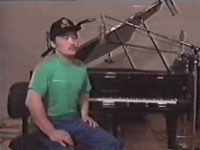
[Anatoli Kuular performing the Borbangnadyr used in "Calculus" at UMRK, January 8, 1993.]
C. F. Ekman
There's an '93 Irish Times article on Zappa (on one of the better FZ web sites—Evil Bob's, I think) in which Zappa mentions the Chieftains/Tuvan tapes—one of the pieces, he stressed, was based on calculus. And there is a track listing on Dance Me This (not released yet—who knows when?) called "Calculus." Maybe that's it.
Paul Hinrichs
I wonder if that would be integral or differential calculus?
If the latter, you could make a case that all music is based on calculus, because something changes over time. Not to be condescending or anything, but a mental picture of the Tuvans crouching over a table scribbling squiggly integral lines and sigmas, and arguing whether the limits should be from negative infinity to 0 or from negative infinity to positive infinity, strikes me as unlikely. And then, even if they do it, how do they explain it to the Chieftains?—"Okay, man. like here—we've calculated the spectral density of a saturated saline solution and mapped it across a mobious toroid whose surface degenerates over time according to a formula based on the Heisenberg paradox, so that means you guys start out in D-flat minor and we'll start chuggin away in 7/8—Everbody ready?"
Zappa presented the Tuvans with a tape of the performances they did for him during Zappa-Tuva I, and a little "extra something." The performances were very good, and the tape (to my ignorant ears) sounded well engineered. The "extra something" turned out to be a solo track by Anatoly Kuular, to which Zappa's engineer had overdubbed some funky bass and rhythm ("using calculus!" Zappa repeated many times).
Brandon Amison, quoted in Splat's Zappapage
The Tuvans sang in "Free Time" (no click track for reference). Todd Yvega wanted to show FZ how it is possible to have the Synclavier match a constantly changing external tempo. Todd wrote a neat musical sequence in Script (a music/computer language in the Synclavier).
Tempos were approximated at every realistic interval. Todd then used Cubic Splines (something used in Calculus) to "fill in the spaces" (speeding up and slowing down in a non- linear manner). The Synclavier now accurately followed the Tuvans.
The late Frank Zappa's last work, "Civilization, Phaze III", has just been released. The two CD set features an amazing composition featuring the throat-singing of Kaigal-ool Khovalyg and Anatoli Kuular, recorded at Zappa's studio in January, 1993. The composition is awesome—when I heard it, I imagined Frank Zappa out in the cosmos, tapping into the energies of the universe.
PostScript: As it turns out, the only throat-singing apparent on the "Civilization, Phaze III" CD is some sampled kargyraa at the start of the track "Dio Fa". The amazing composition referred to is actually scheduled to appear as part of "Dance Me This", which has not yet been released. —October, 1998.
Rip Rense, Denver Post, February 28, c. 1998
"Dance Me This"— An album of Synclavier works in the tradition of Zappa's Grammy-winning "Jazz From Hell." It was named for a remarkable track featuring Tuvan "throat singers," members of a northern China tribe able to sing in nasal multitones. A group of Tuvan musicians visiting L.A. paid Zappa a visit in 1993 and promptly was recorded. A Synclavier piece was later added to the Tuvans, with the aid of a computerized "tempo map" to match it with their changing, imprecise rhythms—yielding a sort of avant-garde Tuvan hiphop. Zappa reportedly was "tickled" with the result.
Regarding Dance Me This, Todd [Yvega] spoke about the final track, which came about from what Frank referred to as 'burglar music'; he'd frequently ask Todd to use algorithms to create new pieces, but told him not to spend more than five minutes on them (a quick in-and-out, see?). Calculus is one such piece.
Type of Work: Music
Registration Number / Date: PAu001959058 / 1995-02-06
Supplement to: PAu001909997 / 1994
Title: Calculus. By Frank Zappa, 1940-1993.
Notes: Statement re transfer.
Copyright Claimant: Todd Yvega d.b.a. Propeller-head Publishing (on original appl.: Zappa Family Trust)
Authorship on Application: Todd Yvega (additional author)
Supplement to Registration: PAu 1-909-997, 1994
Variant title: Calculus.
Borbangnadyr
Borbangnadyr (Борбаңнадыр) is a trill reminiscent of birds and traveling brooks, made by a light rapid quivering of the lips.
Additional informants: Charles Ulrich, Javier Marcote.
